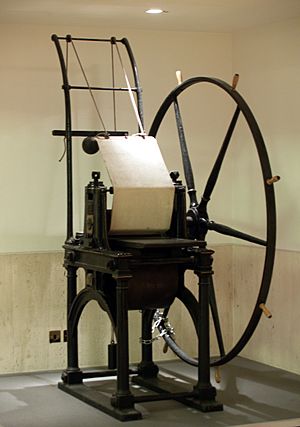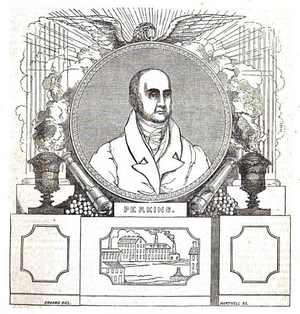Jacob Perkins facts for kids
Quick facts for kids
Jacob Perkins
|
|
|---|---|

Portrait of Perkins by Thomas Edwards (printed by Pendleton's Lithography), 1826
|
|
| Born | July 9, 1766 |
| Died | July 30, 1849 (aged 83) London, England
|
| Nationality | American |
| Occupation | Inventor, mechanical engineer, physicist |
Jacob Perkins (born July 9, 1766 – died July 30, 1849) was an American inventor, a mechanical engineer (someone who designs and builds machines), and a physicist (a scientist who studies how the world works). He was born in Newburyport, Massachusetts.
Jacob Perkins started as an apprentice to a goldsmith. He quickly became known for his many useful inventions. He received 21 patents in America and 19 in England. He is often called the "father of the refrigerator" because of his work on cooling machines. He was also chosen to be a member of important science groups, like the American Academy of Arts and Sciences.
Contents
Early Life and First Jobs
Jacob Perkins went to school in Newburyport until he was twelve years old. Then, he began learning the goldsmith trade from a man named Mr. Davis. When Mr. Davis passed away three years later, Jacob was only fifteen. He bravely continued the business, making gold beads and even adding shoe buckles to his products.
When he was twenty-one, the head of the Massachusetts mint hired him. Jacob's job was to create a special metal stamp, called a die. This die was used to make copper pennies with an eagle and an Indian design.
Amazing Inventions
Machines for Making Nails
In 1790, when Jacob was 24, he invented machines that could cut and shape nails. In 1795, he received a patent for his improved nail machines. He then started his own business making nails in Amesbury, Massachusetts.
Working with Cannons
During the War of 1812, Jacob Perkins helped with the war effort. He worked on machines used to make cannons. These machines helped to bore out the inside of the cannons.
Studying Water Pressure
Jacob also studied how water pressure works. He invented a special tool called a bathometer or piezometer. This device could measure how deep the sea was by checking the pressure of the water.
New Ways to Engrave and Print
Jacob Perkins became very skilled at making steel plates for engraving. Engraving is a way of carving designs onto a surface. He started a printing business with an engraver named Gideon Fairman. They first printed school books. They also printed money that was very hard to copy, which helped prevent fake money.
In 1809, Jacob bought a special technology called "stereotype." This technology helped prevent counterfeit bills. He registered the patent and hired the original inventor, Asa Spencer. Perkins made important improvements in printing. He created new steel engraving plates. Using these plates, he printed the first known American books made with steel engraving. He then printed money for a bank in Boston and later for the National Bank.
In 1819, Jacob Perkins and Gideon Fairman went to England. They hoped to win a large reward for creating "unforgable notes" (money that couldn't be faked). They showed their sample notes to important people, but the English thought the inventor should be from England.
Even so, Perkins's printing of English money was a success. He partnered with an English engraver named Charles Heath. Their company was called Perkins, Fairman and Heath. Later, Jacob's son-in-law, Joshua Butters Bacon, bought out Charles Heath's share. The company then became known as Perkins Bacon. This company printed banknotes for many banks and even made postage stamps for other countries. They started making stamps for the British government in 1840. These included the famous Penny Black stamp. Their stamps were the first known pre-glued stamps.
Heating and Cooling Systems
Jacob Perkins also held patents for heating and air conditioning technology. In 1829, he teamed up with his second son, Angier March Perkins. They built and installed central heating systems using Jacob's special "hermetic tube" idea.
He also looked into refrigeration (cooling) machines. He discovered that a liquid called ammonia could create a cooling effect. This discovery was important for his later work on refrigerators.
Steam Power Inventions
In 1816, Jacob Perkins worked on steam power with Oliver Evans in Philadelphia. In 1822, he built an experimental high-pressure steam engine. This engine worked at very high pressures. While it wasn't practical for the technology of his time, his ideas were used again much later.
Perkins's boiler was a new type called a flash boiler. It was also one of the first examples of a contra-flow heat exchanger. This means it was designed to transfer heat very efficiently.
Perkins also used his high-pressure steam technology in another invention: the steam gun. This was an early type of machine gun that used steam instead of gunpowder. It could fire many rounds very quickly. It is said that the Duke of Wellington thought it was "too destructive."
In 1827, he was the first person in England to use a uniflow steam engine. He also applied his hermetic tube system to steam locomotive boilers. In 1836, several locomotives were built using his high-pressure steam system.
National Gallery of Practical Science
In 1832, Perkins opened the National Gallery of Practical Science in London. This place was dedicated to showing off modern inventions. A very popular display there was his steam gun.
The First Refrigerator Patent
Jacob Perkins is known for getting the first patent for the vapor-compression refrigeration cycle. This patent was given on August 14, 1834. It was for an "Apparatus and means for producing ice, and in cooling fluids." The basic idea for this had come from another American inventor, Oliver Evans, in 1805. However, Evans never actually built a refrigerator.
Business Challenges
Jacob Perkins and Charles Heath had many successful businesses together. However, they also faced financial difficulties at times. They kept careful records of their money and shared investments. Their business partnership ended when Jacob's son-in-law, Joshua Butters Bacon, bought Charles Heath's share of their printing business. This is when the company became Perkins Bacon. At one point, Jacob faced lawsuits and had to close his engine factory.
His Family
Jacob Perkins married Hannah Greenleaf in 1790. They had nine children together. His second son, Angier March Perkins (1799–1881), moved to England in 1827. He worked with his father and later took over the business after Jacob's death. Jacob's grandson, Loftus Perkins (1834–1891), also spent most of his life in England. He experimented with using very high-pressure steam in engines.
Later Life and Death
Jacob Perkins retired in 1843. He passed away in London on July 30, 1849, at the age of 83. He was buried in Kensal Green Cemetery in London.
|
See also
 In Spanish: Jacob Perkins para niños
In Spanish: Jacob Perkins para niños



